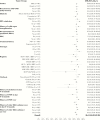Expanding Hepatitis C Virus Care and Cure: National Experience Using a Clinical Pharmacist-Driven Model
- PMID: 31363775
- PMCID: PMC6667715
- DOI: 10.1093/ofid/ofz316
Expanding Hepatitis C Virus Care and Cure: National Experience Using a Clinical Pharmacist-Driven Model
Abstract
Background: The US National Viral Hepatitis Action Plan depends on additional providers to expand hepatitis C virus (HCV) treatment capacity in order to achieve elimination goals. Clinical pharmacists manage treatment and medication within interdisciplinary teams. The study's objective was to determine sustained virologic response (SVR) rates for clinical pharmacist-delivered HCV therapy in an open medical system.
Methods: Investigators conducted a multicenter retrospective cohort study of patients initiating direct-acting antivirals from January 1, 2014, through March 12, 2018. Data included demographics, comorbidities, treatment, and clinical outcomes. The primary outcome of SVR was determined for patients initiating (intent-to-treat) and those who completed (per-protocol) treatment. Chi-square tests were conducted to identify associations between SVR and adverse reactions, drug-drug interactions, and adherence.
Results: A total of 1253 patients initiated treatment; 95 were lost to follow-up, and 24 discontinued therapy. SVR rates were 95.1% (1079/1134) per protocol and 86.1% (1079/1253) intent to treat. The mean age (SD) was 57.4 (10.1) years, the mean body mass index (SD) was 28.7 (6.2) kg/m2, 63.9% were male, 53.7% were black, 40.3% were cirrhotic, 88.4% were genotype 1, and 81.6% were treatment-naïve. Patients missing ≥1 dose had an SVR of 74.9%; full adherence yielded 90% (P < .0001).
Conclusions: HCV treatment by clinical pharmacists in an open medical system resulted in high SVR rates comparable to real-world studies with specialists and nonspecialists. These findings demonstrate the success of a clinical pharmacist-delivered method for HCV treatment expansion and elimination.
Keywords: HCV elimination; clinical pharmacists; direct-acting antiviral; hepatitis C virus; interdisciplinary.
© The Author(s) 2019. Published by Oxford University Press on behalf of Infectious Diseases Society of America.
Figures


Similar articles
-
Clinical effectiveness of pharmacist-led versus conventionally delivered antiviral treatment for hepatitis C virus in patients receiving opioid substitution therapy: a pragmatic, cluster-randomised trial.Lancet Gastroenterol Hepatol. 2020 Sep;5(9):809-818. doi: 10.1016/S2468-1253(20)30120-5. Epub 2020 Jun 8. Lancet Gastroenterol Hepatol. 2020. PMID: 32526210 Clinical Trial.
-
Treatment outcomes of patients with chronic hepatitis C receiving sofosbuvir-based combination therapy within national hepatitis C elimination program in the country of Georgia.BMC Infect Dis. 2020 Jan 10;20(1):30. doi: 10.1186/s12879-019-4741-5. BMC Infect Dis. 2020. PMID: 31924172 Free PMC article.
-
Real-world effectiveness of daclatasvir plus sofosbuvir and velpatasvir/sofosbuvir in hepatitis C genotype 2 and 3.J Hepatol. 2019 Jan;70(1):15-23. doi: 10.1016/j.jhep.2018.09.018. Epub 2018 Sep 26. J Hepatol. 2019. PMID: 30266283
-
Closing the Gap: The Challenges of Treating Hepatitis C Virus Genotype 3 Infection.Pharmacotherapy. 2017 Jun;37(6):735-747. doi: 10.1002/phar.1933. Epub 2017 May 12. Pharmacotherapy. 2017. PMID: 28374965 Review.
-
Similar Sustained Virologic Response in Real-World and Clinical Trial Studies of Hepatitis C/Human Immunodeficiency Virus Coinfection.Dig Dis Sci. 2018 Nov;63(11):2829-2839. doi: 10.1007/s10620-018-5215-0. Epub 2018 Aug 9. Dig Dis Sci. 2018. PMID: 30094623 Review.
Cited by
-
Impact of an interdisciplinary patient care model and routine screening on clinical outcomes in patients with hepatitis C.Innov Pharm. 2023 Oct 10;14(2):10.24926/iip.v14i2.5114. doi: 10.24926/iip.v14i2.5114. eCollection 2023. Innov Pharm. 2023. PMID: 38025170 Free PMC article.
-
Barriers and facilitators to implementing a Pharmacist, Physician, and Patient Navigator-Collaborative Care Model (PPP-CCM) to treat hepatitis C among people who inject drugs.Int J Drug Policy. 2023 Jan;111:103924. doi: 10.1016/j.drugpo.2022.103924. Epub 2022 Dec 13. Int J Drug Policy. 2023. PMID: 36521197 Free PMC article.
-
Specialty pharmacist integration into an outpatient neurology clinic improves pimavanserin access.Ment Health Clin. 2021 May 12;11(3):187-193. doi: 10.9740/mhc.2021.05.187. eCollection 2021 May. Ment Health Clin. 2021. PMID: 34026394 Free PMC article.
-
Can community pharmacists treat hepatitis C virus?Lancet Gastroenterol Hepatol. 2020 Sep;5(9):790-791. doi: 10.1016/S2468-1253(20)30184-9. Epub 2020 Jun 8. Lancet Gastroenterol Hepatol. 2020. PMID: 32526211 Free PMC article. No abstract available.
-
'Treat my whole person, not just my condition': qualitative explorations of hepatitis C care delivery preferences among people who inject drugs.Addict Sci Clin Pract. 2021 Aug 12;16(1):52. doi: 10.1186/s13722-021-00260-8. Addict Sci Clin Pract. 2021. PMID: 34384494 Free PMC article.
References
-
- Centers for Disease Control and Prevention. Surveillance for viral hepatitis – United States, 2016. Available at: https://www.cdc.gov/hepatitis/statistics/2016surveillance/index.htm. Accessed 20 June 2019.
-
- Ottman AA, Townsend ML, Hashem MG, et al. . Incidence of drug interactions identified by clinical pharmacists in veterans initiating treatment for chronic hepatitis C infection. Ann Pharmacother 2018; 52:763–8. - PubMed
LinkOut - more resources
Full Text Sources

